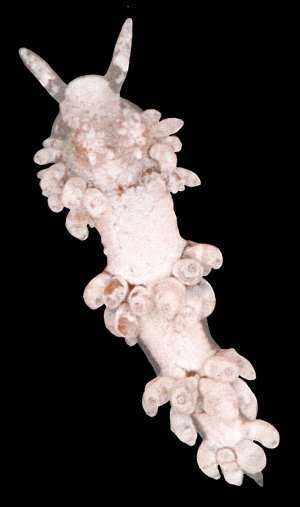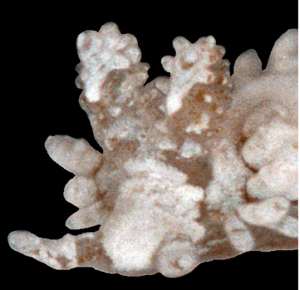

Spurilla creutzbergi
(Marcus & Marcus, 1970)
Order: NUDIBRANCHIA
Suborder: AEOLIDINA
Family: Aeolidiidae
DISTRIBUTION
Known only from the Caribbean
PHOTO
4.5mm specimen, dredged from Thalassia in 3m off Channel Cay, Abaco, Bahamas, August 20, 2003. Photo: Colin Redfern.
I think this is what Marcus & Marcus (1970) called Berghia creutzbergi. They described this species from a single specimen from Curacao which they describe as:
Alive 15mm long, brown with white spots on back and cerata. Tentacles had brown bases and white distal halves.... [In preserved specimen ] rhinophores beset with .. tubercles on all sides ..
Colin Redfern's observations confirm that the body is brownish, although with heavy white pigmentation on the dorsum, and that the rhinophores, as described by Marcus & Marcus (1970), are 'beset with tubercles'. As noted by Edmunds & Just (1983), and Redfern, the cerata rock from side to side when the animal is in motion, in a very distinctive movement. It also appears that the brown background colour is caused by zooxanthellae in ducts of the digestive gland, ramifying through the body wall [see reply to Colin Redferns's message.]
I suspect some of the white spotted animals from the Caribbean which have been tentatively identified on the Forum as Spurilla neapolitana [see messages from Colombia - message 1, message 2] may also be Spurilla creutzbergi but I can't see enough detail in their rhinophores. Some, such as David Behrens animal from Belize, cannot be this species because the rhinophores are clearly ridged transversely.
Clearly this is another Caribbean group that could do with some anatomical work.
References:
• Edmunds & Just. 1983. Eolid nudibranchiate Mollusca from Barbados. Journal of Molluscan Studies, 49: 185-203.
• Marcus, Er. & Ev. Marcus. 1970. Opisthobranchs from Curacao and faunistically related regions. Studies on the Fauna of Curacao and other Caribbean Islands, 33: 1-129.
• Redfern. C., 2001. Bahamian Seashells: a Thousand Species from Abaco, Bahamas.
Rudman, W.B., 2003 (October 15) Spurilla creutzbergi (Marcus & Marcus, 1970). [In] Sea Slug Forum. Australian Museum, Sydney. Available from http://www.seaslugforum.net/find/spurcreu
Related messages
New records from Brazil [2]
August 23, 2007
From: Vinicius Padula

Dear Bill,
In our new paper [see #20244 ] there are new records of some species for Brazilian waters including Berghia creutzbergi. Furthermore, the unidentified aeolid from Florida [message #8324] appears to be Berghia creutzbergi.
- Padula, V. and Santos, F. N. (2006) Three new records of Nudibranchia (Mollusca, Gastropoda) - Additions on the Brazilian Biodiversity. Biociencias, Porto Alegre, 14: 214-220.
Best wishes,
Vinicius
viniciuspadula@yahoo.com
Padula, V., 2007 (Aug 23) New records from Brazil [2]. [Message in] Sea Slug Forum. Australian Museum, Sydney. Available from http://www.seaslugforum.net/find/20556Thanks Vinicius,
I would agree with your identification though I prefer to leave the species in Spurilla until this group of aeolids is revised.
Best wishes,
Bill Rudman
Spurilla creutzbergi? from Jamaica
October 22, 2003
From: Ross W. Gundersen


Dear Bill:
Here is another sea slug from Jamaica. As I said in my first message, all specimens were collected from St. Ann's Bay, Jamaica, West Indies. Most specimens were collected using a light weight dredge and photographed by R. Gundersen.
This was 1.5 cm in length. Dredged at 5 m in Thallassia.
Exhibit peculiar rocking motion when moving (video). Similar to Spurilla neapolitana, but with irregular shaped cerrata.
Best wishes,
Ross
ross.gundersen@uwp.edu
Gundersen, R.W., 2003 (Oct 22) Spurilla creutzbergi? from Jamaica. [Message in] Sea Slug Forum. Australian Museum, Sydney. Available from http://www.seaslugforum.net/find/11136Dear Ross,
This is a bit of a puzzle. It certainly looks like the animal Colin Redfern has identified as Spurilla creutzbergi in ceratal shape and arrangement, and the 'peculiar rocking motion' ceratinly fit observations by Redfern and Edmunds & Just [see Colin Redfern's message]. On e apparent difference however is that your animal seems to have lamellate rhinophores.
I think we would need to have larger images so we could see a more detail to be sure. I'll tentatively identify it as Spurilla creutzbergi but I'm not convinced
Best wishes
Bill Rudman
Spurilla creutzbergi from the Bahamas
October 22, 2003
From: Colin Redfern

Dear Bill,
Following my other message here is another example recently collected of what I have been calling Spurilla creutzbergi from the Bahamas. The 4.5mm specimen figured in Bahamian Seashells (pl. 120, fig. 745) lacked cerata across the dorsum, which allowed the brown body to show through.
Attached are photos of the second 4.5mm specimen, which was dredged from Thalassia in 3m off Channel Cay, Abaco, Bahamas on August 20, 2003. These confirm that the body is in fact brown, although with heavy white pigmentation on the dorsum, and that the rhinophores, as described by Marcus & Marcus (1970) for S. creutzbergi, are beset with tubercles.
As noted by Edmunds & Just (1983), the cerata rock from side to side when the animal is in motion, and this movement is quite distinctive.
• Edmunds & Just. 1983. Eolid nudibranchiate Mollusca from Barbados. Journal of Molluscan Studies, 49: 185-203.
• Marcus, Er. & Ev. Marcus. 1970. Opisthobranchs from Curacao and faunistically related regions. Studies on the Fauna of Curacao and other Caribbean Islands, 33: 1-129.
Best wishes,
Colin
bahamianseashells@att.net



Thanks Colin,
This animal certainly has papillae all around the rhinophore club and so fits the Marcus description. I have included a couple of over blown-up parts of one of your photos to show the brown is almost certainly zooxanthellae in branches of the digestive gland, which apparently ramify up into the rhinophore and out on to the foot.
I didn't know what Edmunds & Just's record referred to as the gave little information, but it is interesting to both them and you noted a peculiar rhythmical movement of the cerata. It joins with Aeolidiella alba and Limenandra nodosa as another member of the Aeolidiidae with very noticeable rhythmical waving of their cerata.
It's a pity that the original description of this species was so lacking in information, but the tuberculate rhinophores certainly suggest Ross Gundersen's animal, is not Spurilla creutzbergi.
Best wishes,
Bill Rudman
Aeolid from Florida?
November 14, 2002
From: Angelo


Found this little critter on the glass today. Then he took off to the rocks. Checked the Hitchhiker FAQ...can't seem to find an ID for it. I have "Gulf-view" Florida Rock and some garf grunge. Maybe he snuck in through those.
About 1" long.
Any ideas?
Thanks,
Angelo
angelo@gloproductions.net
Angelo, 2002 (Nov 14) Aeolid from Florida?. [Message in] Sea Slug Forum. Australian Museum, Sydney. Available from http://www.seaslugforum.net/find/8324Note added 23 August 2007: This is probably Spurilla creutzbergi [see message #20244]
Dear Angelo,
This is an aeolid nudibranch but I can't say much more. I would need to know where it came from with more certainty, and a better photo of the head. If it is from Florida, it has a fairly characteristic shape, so if you are lucky someone may recognise it.
Best wishes,
Bill Rudman
